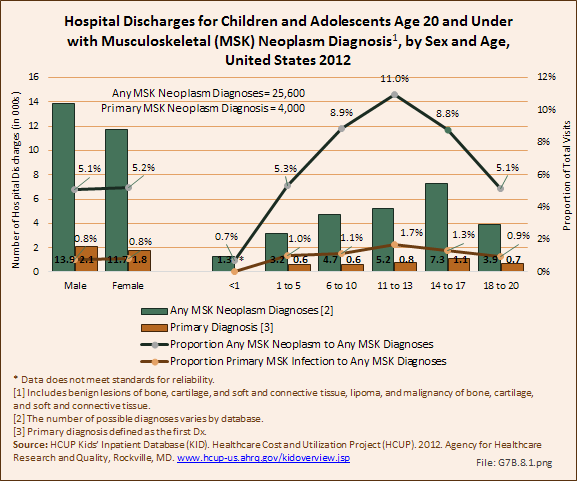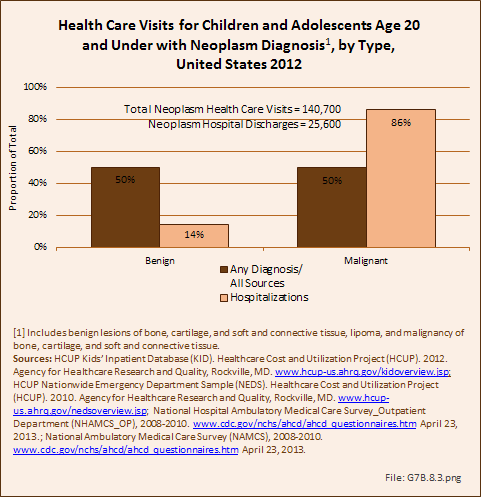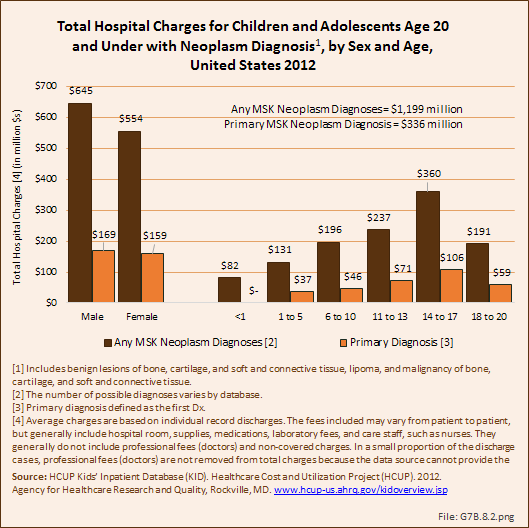

Pediatric musculoskeletal neoplasms are relatively rare. They can be categorized as either benign or malignant, as has been done for this document. Musculoskeletal neoplasms are often also categorized by the type of tissue they produce or from which they are derived.
The most common types of tumors that affect the musculoskeletal system by tissue type are cysts, bone-producing tumors, cartilage tumors, fibrous tumors, soft tissue tumors, and peripheral neuroectodermal tumors. Most benign tumors, such as nonossifying fibromas, result in little or no disability and require no treatment. Other benign tumors may require surgical intervention. Painful or prominent osteochondromas may require surgical excision. Simple bone cysts can weaken the bone and increase fracture risk, and may require surgery treatment in order to resolve the cyst and prevent fracture. Other benign tumors include lipomas, fibrous dysplasia, enchondromas, osteoid osteoma, and osteoblastomas.
The most common malignant tumors of the pediatric musculoskeletal system are osteosarcoma, Ewing sarcoma/peripheral neuroectodermal tumor, rhabdomyosarcoma, and synovial cell sarcoma. Osteosarcoma is the most common malignant bone tumor in patients under 20 years of age, with an incidence of around 29 per 1 million people. Ewing sarcoma is the second most common pediatric malignant musculoskeletal tumor and is part of the Ewing family of tumors, which includes peripheral neuroectodermal tumors. Most of the tumors in the family have the genetic translocation.1 Long-term survival of patients with both of these tumors has drastically improved with the routine use of adjuvant chemotherapy.
For additional information on musculoskeletal tumors in children you can refer to the Tumors [1] section of this report.
Neoplasms, including both benign and malignant, were diagnosed in 140,700 children and adolescent health care visits in 2012, of which 84,500 had a primary diagnosis of a neoplasm. About one in five (18%) of children and adolescents with any neoplasm diagnoses were hospitalized (25,600), but fewer than 5% (4,000) with a primary diagnosis of a neoplasm had a hospital discharge. (Reference Table 7.1.1 PDF [2] CSV [3] and Table 7.1.2 PDF [4] CSV [5])
Slightly more males than females had a hospital discharge with any or a primary neoplasm diagnosis. As children age, there is a higher incidence of neoplasm prevalence resulting in hospitalization.
Any diagnoses of neoplasm accounted for 5% of hospitalizations for any musculoskeletal condition diagnosis, and 0.4% of all hospitalizations for any health care condition. Hospitalizations with a primary diagnosis of neoplasm were 0.8% of all musculoskeletal diagnoses and 0.1% of hospitalizations for any health condition diagnosis. (Reference Table 7.8 PDF [6] CSV [7])

Neoplasm diagnoses are divided equally between benign and malignant neoplasm for any diagnoses and all sources, but 86% of hospitalized diagnoses are malignant.

Total charges averaged $46,900 for a mean 4.6-day stay when children and adolescents were hospitalized with any diagnosis of neoplasm along with other medical conditions. With a primary neoplasm diagnosis, the stay was slightly longer (6.2 days), and mean charges were higher at $84,100. Mean charges and length of stay were highest for children ages 14 to 17 years, but the increase rose steadily from the youngest patients. Total hospital charges for primary neoplasm diagnosis discharges in 2012 were $336.3 million. (Reference Table 7.8 PDF [6] CSV [7])

Links:
[1] https://bmus.latticegroup.com/2014-report/ixac10/childhood-cancers
[2] https://bmus.latticegroup.com/docs/T7.1.1.pdf
[3] https://bmus.latticegroup.com/docs/T7.1.1.csv
[4] https://bmus.latticegroup.com/docs/T7.1.2.pdf
[5] https://bmus.latticegroup.com/docs/T7.1.2.csv
[6] https://bmus.latticegroup.com/docs/T7.8.pdf
[7] https://bmus.latticegroup.com/docs/T7.8.csv